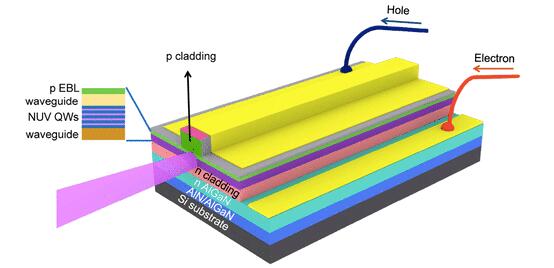Chinese researchers succeeded in fabricating and demonstrating an electrically-injected near-ultraviolet laser using AlGaN on Si. Researchers from the Key Laboratory of Nano-devices and Applications, Suzhou Institute of Nano-Tech and Nano-Bionics, Chinese Academy of Sciences (CAS), Suzhou, China University of Science and Technology Beijing, and the School of Nano Technology and Nano Bionics, University of Science and Technology of China in Hefei, China reported the development. The researchers detailed their findings in ACS Photonics.

Schematic of AlGaN on Si electrically pumped near UV laser diode — ©ACS Photonics The scientists engineered an Al-composition step down-graded AlN over AlGaN multilayer buffer that was able to accommodate the enormous difference in the coefficient of thermal expansion between AlGaN template and Si substrate, and also decrease the threading dislocation density that the large lattice mismatch caused. They grew high-quality InGaN/AlGaN quantum wells on top of a crack-free n-AlGaN template. A waveguide and optical cladding layers were placed on either side of these quantum wells in the edge-emitting laser diode. The researchers pointed to a distinct discontinuity in the slope of light output power plotted as a function of the injection current, a dramatic reduction of the electroluminescence spectral line-width, and an elongated far-field pattern as proof of lasing. Reference Feng Meixin, Li Zengcheng, et al. Room-Temperature Electrically Injected AlGaN-Based Near-Ultraviolet Laser Grown on Si, ACS Photonics, 2018, 5 (3), 699–704. |

